Aquilegias are also known as Columbines or Granny's Bonnets. They are a hardy perennial plant suitable for Temperate to cooler climates. They can be grown in warmer areas but they may suffer from Mildew, a fungal disease caused by humidity. These plants are one of my favourites, growing naturally in Meadows of the Northern Hemishphere. I love the shape of the flowers and the amazing colours. Here in Sydney, they are just starting to grow after the dormant winter period. Mine have only just started to grow their first leaves. There are quite a few varieties, ranging from taller plants around 60 cm to smaller ones around 20 cm high. Plant them in a semi-shaded sheltered spot, under some trees or in pots. I have seen some great plants in Sydney, but since they are not flowering here, i had to borrow this image from a grower's website.

Source ; https://www.tesselaar.net.au/product/4913-aquilegia-songbirds-collection
One of the sweetest flowers in spring gardens is the Columbine. Columbine plants (Aquilegia) have an airy appearance, with small, rounded leaves and tall flower stalks that hold the blooms above the foliage.
Source
Aquilegia's bell-shaped flowers are popular with hummingbirds, bees, and gardeners. The mid-spring blooms fill the void between early spring bulbs and peak garden season.
Source
Source
Columbine flowers are associated with woodland gardens, but most are widely adaptable. Most varieties of Columbine plants will bloom for at least four weeks. They are tougher plants than they appear, but they tend to be short-lived perennials.
Source
Source
However, they will seed and spread, remaining in your garden for years.
Text Source
Fav. comment Award ! You chose great pics and information on Aquilegias. Well done .
Thank you 🙏!
Sometimes known as columbines or granny’s bonnets, aquilegias are charming, old-fashioned cottage garden plants with bonnet-shaped flowers, often two-tone and with long graceful spurs. They come in a very wide range of colours, from white to pale pink and from dark purple to red.
Flowering in early summer, aquilegias fill the seasonal gap between the last of the spring bulbs and the first of the summer flowers. They self-seed readily, and look wonderful naturalised amongst shrubs and roses. However, the plants interbreed freely and seedlings rarely resemble the parents. If you’d rather avoid this, deadhead plants after flowering to prevent self-seeding.
Grow aquilegias from seed, or buy them as plants at the garden centre. Grow in fertile, moist but well-drained soil in sun to partial shade, in the middle of the border.
Lift and divide clumps every three to five years and mulch annually with well-rotted manure or compost.
https://www.gardenersworld.com/plants/10-aquilegias/
Congrats, you won the Fav. comment Award shared with another Steemian. Great choice of pics showing leaves and flowers.
That is a amazing flowers and really beautiful . the beat of garden.



Thanks for the information.
https://encrypted-tbn0.gstatic.com/images?q=tbn:ANd9GcQUp1ARKZukRYSCBA51ZD7qifHIoK4MrHwjpChdnr4KOjXiw70q
100% like and resteem
Silly Sausage Award ! Great choice of Pics for this plant.
Aquilegia Vulgaris Picture: Andrew Crowley
Only a few Far Eastern aquilegias are in general cultivation. A. viridiflora is a small, dainty plant, with numerous nodding flowers of chocolate-brown and mossy green. It is best grown in an elevated position, such as a raised bed, where its delicious perfume and subtle demeanour can be enjoyed at close quarters.
In Japan, A. flabellata and its numerous hybrids have long been cultivated, although the species is unknown in the wild. Hybrids like A. flabellata 'Ministar' and A. flabellata 'Nana Alba' are consistently popular among alpine enthusiasts. Its small, stocky plants are loaded with flowers, making up for its lack of grace.
Growing tips
Aquilegias lend themselves to cottagey or semi-wild settings. Most relish dappled shade. They love deep, rich soil. Most garden varieties do not resent clay, but alpine types prefer well-drained loam. When planting, work in extra humus: old muck or garden compost is best. Mulch with the same material.
Remove seed heads before they disperse their contents, otherwise the parent plant may be crowded out by its own offspring. Save the seed and sow it fresh if you want more plants elsewhere.
Good companions
Try A. longissima contrasted against the darkly dramatic foliage of Cimicifuga simplex var. simplex Atropurpurea Group or in combination with pale-lemon buttercups and golden grasses. Plant blue A. alpina as it grows in the wild, with Geranium sylvaticum and trollius. A. formosa and A. canadensis, both of which are soft red and yellow, look at home with Primula cockburniana, a small asiatic primula with vermilion flowers.
https://www.telegraph.co.uk/gardening/howtogrow/3299601/How-to-grow-aquilegia.html
wow,really very fantastic flower pics always showing in your blog. you always giving a big refreshment of my mind to giving flower post.i am always attracted them.every photo you pic up very perfectly.so,its always impressible and my heart touching..this is a very attractive flower of aquilegia flower plant.i sm really appreciating to see your post and i support your every work.because its very perfect and original.i am first time seen this types flower...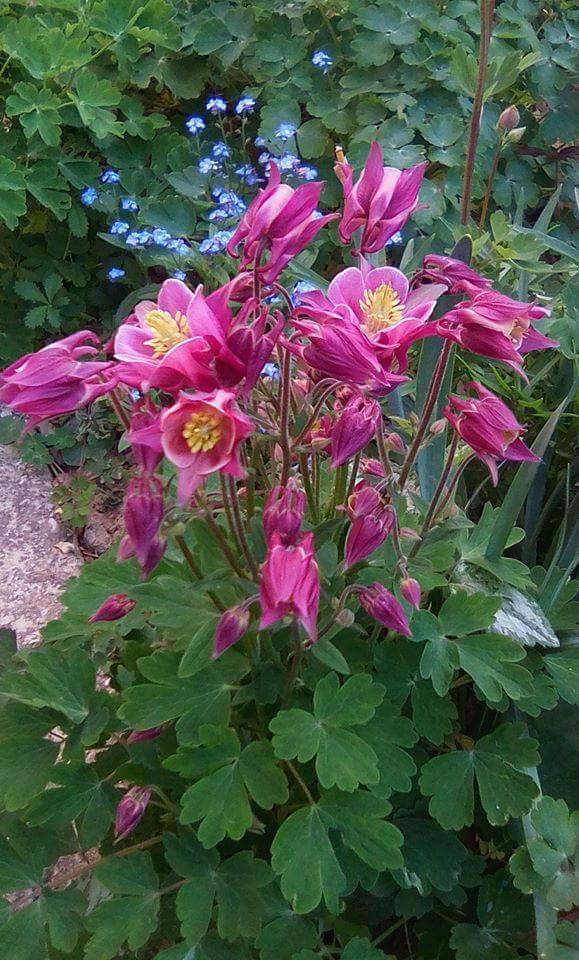 The columbine plant (Aquilegia) is an easy-to-grow perennial that offers seasonal interest throughout much of the year. It blooms in a variety of colors during spring, which emerge from its attractive dark green foliage that turns maroon colored in fall. The bell-shaped flowers are also a favorite to hummingbirds and may be used in cut-flower arrangements as well..
The columbine plant (Aquilegia) is an easy-to-grow perennial that offers seasonal interest throughout much of the year. It blooms in a variety of colors during spring, which emerge from its attractive dark green foliage that turns maroon colored in fall. The bell-shaped flowers are also a favorite to hummingbirds and may be used in cut-flower arrangements as well.. 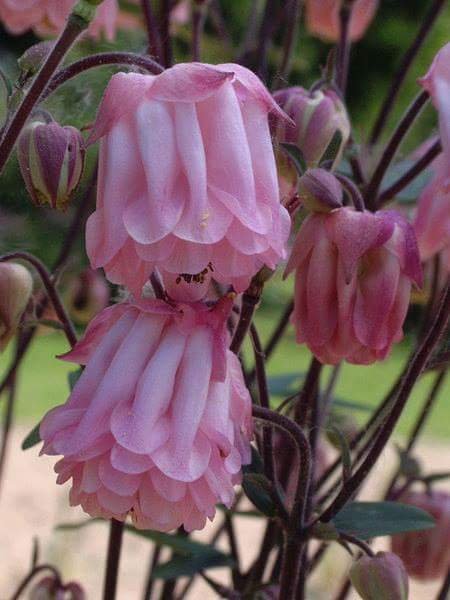 European Columbine (Aquilegia Vulgaris)
European Columbine (Aquilegia Vulgaris)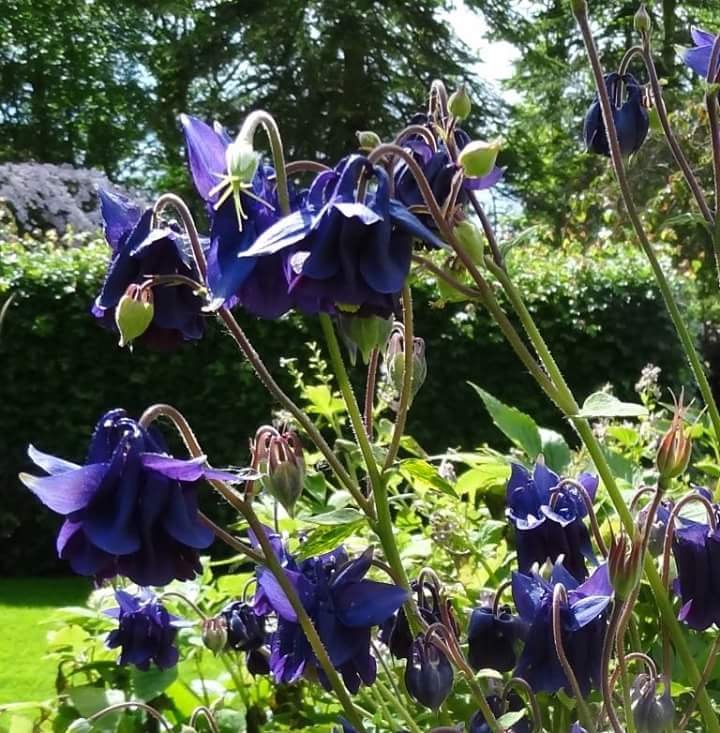 Aquilegia vervaeneana 'Woodside Blue'............
Aquilegia vervaeneana 'Woodside Blue'............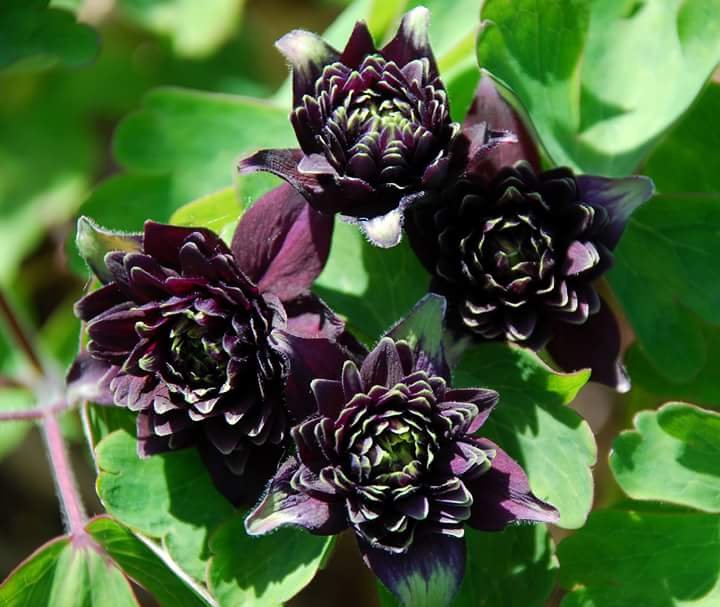 Aquilegias are flowering now. This plant produces bee-pleasing flowers in May, a month when other flowers tend to be in short supply.
Aquilegias are flowering now. This plant produces bee-pleasing flowers in May, a month when other flowers tend to be in short supply.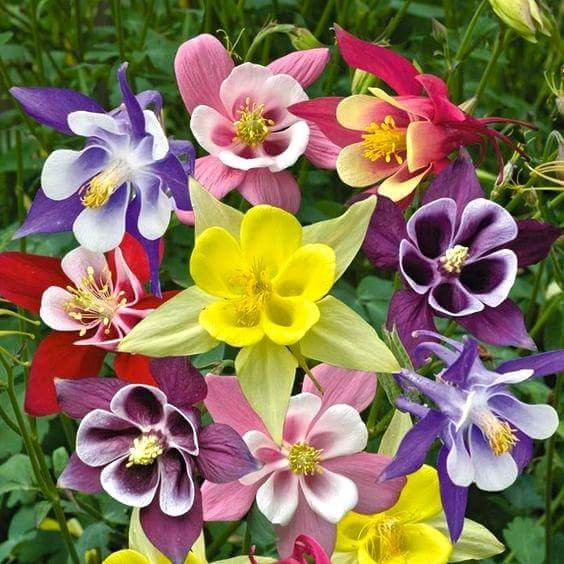 ~ Plants ~
~ Plants ~
This plant has showy flowers that range in color from purple, white, red, and blue. It has a broad long spur stout and is strongly incurved. It attracts humming-birds and bumble-bees.
Perennial – Blooms spring-fall – Zone - Height 10-18” sun to partial shade
OFFERING 50 SEEDS FOR $1.00..
Wonderful Aquilegia with purple blue flowers and great variegated laeves. Even when the plant is nogt flowering, it's still attractive till October...
They are also known also known as Columbines or Granny’s Bonnets and come in many beautiful colours and varieties.
They are extremely easy to grow and self-seed all over the place. You can choose to keep the seedlings and see what comes or just pull them out.
But, left to their habit of promiscuous (!) interbreeding, the flowers will tend to dark blue or red in the end.
We have one posh Aquilegia in the Park, the rest are all cross-breeds. The photo is of the posh one.Aquilegias are flowering now. This plant produces bee-pleasing flowers in May, a month when other flowers tend to be in short supply.
They are also known also known as Columbines or Granny’s Bonnets and come in many beautiful colours and varieties. They are extremely easy to grow and self-seed all over the place.You can choose to keep the seedlings and see what comes or just pull them out.But,left to their habit of promiscuous (!) interbreeding, the flowers will tend to dark blue or red in the end.We have one posh Aquilegia in the Park, the rest are all cross-breeds. The photo is of the posh one.
A columbine is a worthy addition to the witch's garden. Many use this Venus plant in love magic, and it is said to be a favorite of the Fae (it definitely attracts hummingbirds). Europeans have traditionally seen the connection between this plant and birds. The word "columbine" comes from the word for dove--the flower was considered to look like doves in a circle. At the same time, the Latin name, Aquilegia, comes from the word "eagle," as the back of the flower was throught to look like an eagle's talon. There's an interesting juxtaposition between predator and prey going on with this plant (eagle/dove) that is borne out as well in the plant as a whole, as the leaves are very poisonous while the flower of the North American columbines was eaten as a condiment by natives of North America (I wouldn't go testing that out, though). I finally have the wild European columbine seeds in stock again. I also have cultivated European columbine seeds I harvested from my own plants (witch-grown) and the North American wild columbine, a forest beauty.thanks to sharing for your great post with u.. very well done..take care yourself and bezt of luck of your great work.but i am realy bad feel this time.because only one person disturb doing any comment time and telling very wrong word this platform.this person name magoo.i don,t know what,s the oriblem this person.always doing mistake talk every steemians work matter.but any person not take any step this bad person bad work matter.i hope you take step this person bad work and rough talk matter.i hope that you support my work.may god bless you.i want you stayed always live long happily your whole life..my best wishes anytime with you.see you again.. my dear friend.. @ctrl-alt-nwo thank you my best friend have a great day..
Please quote SOURCE for photos, otherwise you just copy others work.
An interesting plant and an interesting story is about it. Aquilegia is also called an orlice or catchment. It belongs to the genus of perennial herbaceous plants of the family of buttercups. According to various sources, this genus combines 60-120 species of diverse plants that grow in the mountain regions of the Northern Hemisphere. Approximately 35 species of this plant are cultivated. Where does the Latin name come from, exactly and is not defined. So, according to one version, the name is formed from words such as aqua - "water" and legere - "collect", and on the other - that this word originated from aquila - "eagle". Such a plant has long been known to flower growers. A reference to it can also be found in fiction. So, in "Hamlet" Ophelia offers Laertes a columbine flower (and this is how England is called aquilegia). And in the Middle Ages, if the artist portrayed the flower of a given plant in the picture, it was indicative of the presence of the Holy Spirit.
https://rastenievod.com/akvilegiya.html
Thank you for the beautiful flowers, I have not met them before ...
Aquilegia, or otherwise - a catchment, is distinguished by a completely unusual form of a flower with a short curved or long straight spur. Flowers are located on tall peduncles, rising above the thick foliage. Aquilegia is a perennial plant, which, nevertheless, regularly (every 3 to 4 years) needs updating landings. However, this is usually not a problem, because the catchments are multiplying well by self-seeding.
Propagation of aquilegia, usually seeds, but also used the division of the bush and cuttings. Share bushes in autumn or early spring. From a large plant, up to five chunks are obtained; each of them must have several developed kidneys. Seeds are sown in the open ground or grown at home seedlings. Most plants give abundant seed.
Planting aquilegia is best placed in the penumbra. They grow in the sun, of course, if they have enough moisture, but such spectacular flowering will not be, and the foliage is shallow. On humus water-permeable, loose soil with sufficient moisture, the plant forms a powerful shrub that is good not only at the time of flowering.
Care of aquilegia consists of watering in arid weather, pruning wilted inflorescences. Tall grades often require support; without it the peduncles in the wind or after the rain break down or lie down on the ground. Thank you @ctrl-alt-nwo
https://7dach.ru/MarinaGerasimenko/izyaschnye-akvilegii---zvezdy-tenistyh-uchastkov-239.html
The genus name Aquilegia is derived from the Latin word for eagle (aquila), because of the shape of the flower petals, which are said to resemble an eagle's claw.
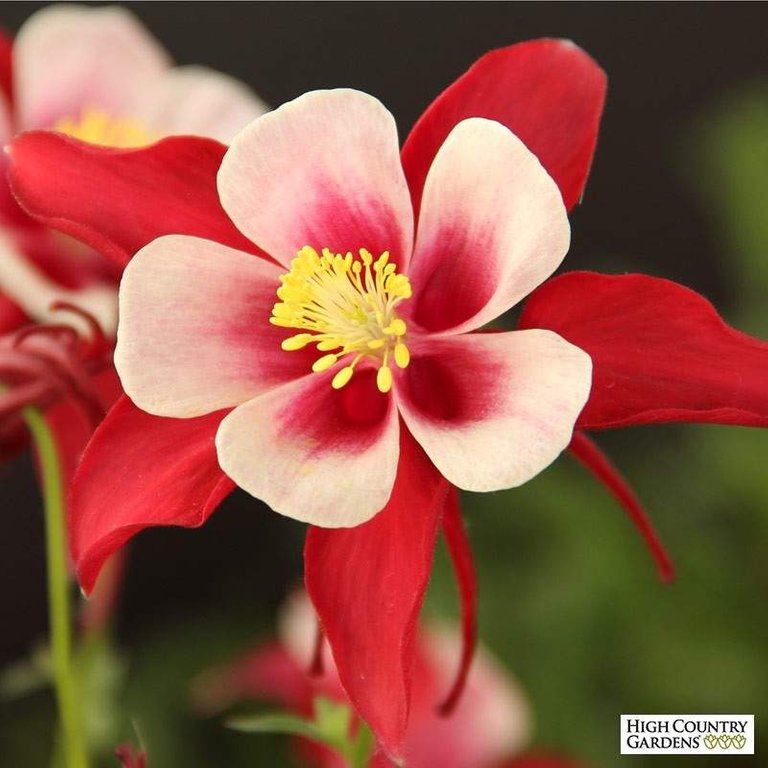


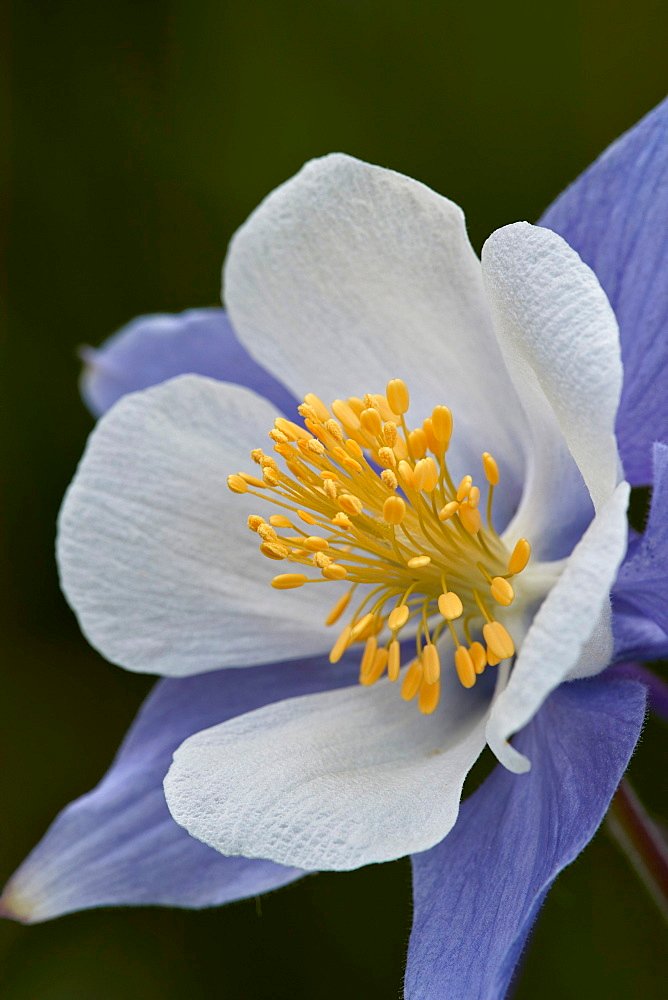
The leaves of this plant are compound and the flowers contain five sepals, five petals and five pistils. The fruit is a follicle which holds many seeds and is formed at the end of the pistils.
Relatives:Columbines are closely related to plants in the genera Actaea (baneberries) and Aconitum (wolfsbanes/monkshoods), which like Aquilegia produce cardiogenic toxins.
Columbines are closely related to plants in the genera Actaea (baneberries) and Aconitum (wolfsbanes/monkshoods), which like Aquilegia produce cardiogenic toxins.
They are used as food plants by some Lepidoptera (butterfly and moth) caterpillars. These are mainly of noctuid moths – noted for feeding on many poisonous plants without harm – such as Cabbage Moth (Mamestra brassicae), Dot Moth (Melanchra persicariae) and Mouse Moth (Amphipyra tragopoginis). The Engrailed (Ectropis crepuscularia), a geometer moth, also uses columbine as a larval foodplant.
Columbine is a hardy perennial, which propagates by seed. It will grow to a height of 15 to 20 inches. It will grow in full sun; however, it prefers growing in partial shade and well drained soil, and is able to tolerate average soils and dry soil conditions.
info-https://en.wikipedia.org/wiki/Aquilegia.
magoo-2 found a series of multi accounts of a same owner is following your articles to cheat your generous rewards.
magoo-2 found these accounts are suspicious & can be multi accounts of a single owner. Conclusion is based on last 30 days transactions:
@rupok
@sarahmcdowell2
@razu788
@tangera
magoo-2
Check our latest multi comment spam update report
Aquilegia Music Series
columbine Music Series
Other common names
columbine Music Series
Family
Ranunculaceae
Genus
Aquilegia are clump-forming herbaceous perennials with long-stalked, ternately divided basal leaves and erect, leafy stems bearing bell-shaped flowers with spreading, coloured sepals and petals with spurs, on branched stems
Details
Music Series is a compact short-lived perennial to 45cm, with long-spurred flowers in shades of red, yellow, blue or white, often bicolored.
https://www.rhs.org.uk/Plants/71392/Aquilegia-Music-Series/Details
Aquilegias

Oh yeah, the colors of aquilegia have the most varied colors, from gently pink to blue or yellow, and will undoubtedly become an ornament of any flowerbed.
Selecting a landing location
The plant is quite sensitive to direct sunlight, and even more so in the hot summer, too strong direct sunlight can destroy the plant. So when choosing a place for planting this plant should be guided by a shadow or partial shade. Planting in the catchment in the ground do not forget that the transplantation of the adult plant can not be carried, it has a fairly powerful root system with an abundance of small roots, reaching in depth and in diameter about 70 cm, and it is easy to damage it with this procedure.
Seed collection
Seeds of this plant can be purchased at any flower shop, or you can collect it yourself. If you already have aquilegia on your flower bed, you can prepare seeds for its propagation without any problems. Seed ripening occurs as a rule in early August, it is necessary to collect dried inflorescences and gently extract seeds from them. You can leave the seeds on the bushes, then multiply by self-seeding.
Aquilegia grows better on moist, fertile, drained soils and they love feeding. On heavy soils, aquileges grow worse, and require frequent loosening.
Seed treatment before sowing.
In spring sowing, the seeds of aquilegia require stratification. They should be kept in the refrigerator for 5 to 6 weeks at a temperature of 0 + 6 ° C, as well as heat treatment - the seeds can be kept for a month at high temperatures up to + 34-36 ° C.
http://www.art-pen.ru/vyrashhivanie-akvilegii-iz-semyan
Aquilegia 'Hensol Harebell'
columbine 'Hensol Harebell'
Other common names
columbine 'Hensol Harebell'
Family
Ranunculaceae
Genus
Aquilegia are clump-forming herbaceous perennials with long-stalked, ternately divided basal leaves and erect, leafy stems bearing bell-shaped flowers with spreading, coloured sepals and petals with spurs, on branched stems
Details
'Hensol Harebell' is an erect herbaceous perennial to 90cm, with divided leaves tinted purple in late summer, and nodding, rich violet-blue flowers 5cm wide, with short, hooked spurs
https://www.rhs.org.uk/Plants/99954/Aquilegia-Hensol-Harebell/Details
Aquilegia
Aquilegia (common names: granny's bonnet[1], columbine) is a genus of about 60–70 species[2] of perennial plants that are found in meadows, woodlands, and at higher altitudes throughout the Northern Hemisphere, known for the spurred petals [3] of their flowers.
Etymology
The genus name Aquilegia is derived from the Latin word for eagle (aquila), because of the shape of the flower petals, which are said to resemble an eagle's claw. The common name "columbine" comes from the Latin for "dove", due to the resemblance of the inverted flower to five doves clustered together.[4]
Description
The leaves of this plant are compound and the flowers contain five sepals, five petals and five pistils. The fruit is a follicle which holds many seeds and is formed at the end of the pistils. Underneath the flower are spurs which contain nectar, mainly consumed by long-beaked birds such as hummingbirds.[5]
Relatives
Columbines are closely related to plants in the genera Actaea (baneberries) and Aconitum (wolfsbanes/monkshoods), which like Aquilegia produce cardiogenic toxins.[6]
Insects
They are used as food plants by some Lepidoptera (butterfly and moth) caterpillars. These are mainly of noctuid moths – noted for feeding on many poisonous plants without harm – such as Cabbage Moth (Mamestra brassicae), Dot Moth (Melanchra persicariae) and Mouse Moth (Amphipyra tragopoginis). The Engrailed (Ectropis crepuscularia), a geometer moth, also uses columbine as a larval foodplant. The larvae of the Papaipema leucostigma feed on columbine.[7]
https://en.wikipedia.org/wiki/Aquilegia
Aquilegia
Aquilegia (common names: granny's bonnet, columbine) is a genus of about 60–70 species of perennial plants that are found in meadows, woodlands, and at higher altitudes throughout the Northern Hemisphere, known for the spurred petals of their flowers.
How to grow: aquilegia
Carol Klein on a plant that looks like a ship's figurehead
IT seems strange that two birds as different as the eagle (in Latin, aquila) and the dove (columbus) should both give their name to the same flower - the aquilegia, or columbine. The petals are supposed to resemble the outspread wings of these birds, and the spurs their arched necks and heads. Whichever name you use, this genus offers some of the most garden-worthy and decorative of plants.
All aquilegias have wonderful foliage that emerges early in the year, creating tuffets of bright green among the sharp verticals of daffodils and other bulbs. They are among the most telling of springtime plants, both for foliage and for flowers.
•Killer disease cripples aquilegia collection
Aquilegia longissima is an exquisite flower. Its petals are a pale, soft, buttery yellow, and its spurs - of a deeper yellow, and sometimes up to 6in (15cm) long - are swept elegantly back, giving the whole flower the look of a ship's figurehead.
Like so many of the most desirable aquilegias, A. longissima comes from the New World, where it grows wild in the mountains of the southernmost states right down to Mexico. Long-spurred hybrids have been developed from it and from several other American species: its close cousin A. chrysantha; A. formosa, which has dainty red-and-yellow flowers; and A. coerulea, a graceful blue-and-white columbine with finely divided "maidenhair" leaves, which the State of Colorado has adopted as its emblem.
The genus aquilegia is widespread in the northern hemisphere: Europe and Asia, as well as America, have their own columbines. Many of the North American species are short-lived, but they can be grown easily from seed.
Aquilegia 'Columbine' Picture: Alamy
https://www.telegraph.co.uk/gardening/howtogrow/3299601/How-to-grow-aquilegia.html
Aquilegia 'Bunting' (Songbird Series)
columbine 'Bunting'
Other common names
columbine 'Bunting'
Family
Ranunculaceae
Genus
Aquilegia are clump-forming herbaceous perennials with long-stalked, ternately divided basal leaves and erect, leafy stems bearing bell-shaped flowers with spreading, coloured sepals and petals with spurs, on branched stems
Details
'Bunting' is a perennial with grey-green, divided foliage and flowers with spreading pale blue sepals and white petals with blue spurs.
https://www.rhs.org.uk/Plants/137982/Aquilegia-Bunting-(Songbird-Series)/Details
Aquilegia 'Tequila Sunrise' Picture: Features Scan
A. alpina is, as the name suggests, from the Alps, where it grows in shady woodland margins and among rocks. Found in the same region, but growing in meadows rather than higher up the slopes, is an aquilegia with almost black flowers, A. atrata. This is probably one of the parents used to create the fashionable "black-and-white" hybrids, two of which, A. vulgaris 'Magpie' and A. vulgaris 'William Guiness', are widely available as seed strains.
From further east, in the Himalayan foothills of Pakistan, northern India and Kashmir comes A. fragrans, one of the commonest columbines. Its pallid, creamy flowers, sometimes washed in pale blue, have a delicious pineapple-like scent. This variety lasts only two or three years in the garden and seed from cultivated plants is often contaminated after cross-pollination with other columbines. The resultant plants often lose the fabulous scent but, thankfully, plant explorers and botanists fairly frequently re-introduce unadulterated seed collected from the wild.
https://www.telegraph.co.uk/gardening/howtogrow/3299601/How-to-grow-aquilegia.html
@ctrl-alt-nwo, That would be perfect introduction of Aquilegias plant with adorable flowers. Your description so powerful. My heart deeply touch with those images. I would like to add some info through web site.
IT seems strange that two birds as different as the eagle (in Latin, aquila) and the dove (columbus) should both give their name to the same flower - the aquilegia, or columbine. The petals are supposed to resemble the outspread wings of these birds, and the spurs their arched necks and heads. Whichever name you use, this genus offers some of the most garden-worthy and decorative of plants.
All aquilegias have wonderful foliage that emerges early in the year, creating tuffets of bright green among the sharp verticals of daffodils and other bulbs. They are among the most telling of springtime plants, both for foliage and for flowers.
Like so many of the most desirable aquilegias, A. longissima comes from the New World, where it grows wild in the mountains of the southernmost states right down to Mexico. Long-spurred hybrids have been developed from it and from several other American species: its close cousin A. chrysantha; A. formosa, which has dainty red-and-yellow flowers; and A. coerulea, a graceful blue-and-white columbine with finely divided "maidenhair" leaves, which the State of Colorado has adopted as its emblem.
The genus aquilegia is widespread in the northern hemisphere: Europe and Asia, as well as America, have their own columbines. Many of the North American species are short-lived, but they can be grown easily from seed.
Thanks for reading & watching.
Source: https://www.telegraph.co.uk/gardening/howtogrow/3299601/How-to-grow-aquilegia.html
One of the sweetest flowers in spring gardens is the Columbine. Columbine plants (Aquilegia) have an airy appearance, with small, rounded leaves and tall flower stalks that hold the blooms above the foliage. Aquilegia's bell-shaped flowers are popular with hummingbirds, bees, and gardeners. The mid-spring blooms fill the void between early spring bulbs and peak garden season. Columbine flowers are associated with woodland gardens, but most are widely adaptable.
Many of the species are native to areas throughout North America, from Canada to Texas.
Most varieties of Columbine plants will bloom for at least four weeks. They are tougher plants than they appear, but they tend to be short-lived perennials. However, they will seed and spread, remaining in your garden for years.
https://www.thespruce.com/how-to-grow-and-care-for-columbines-1402831
Aquilegia is an elegant flower that is easy to grow. It reaches around 60cms in height making it ideal for the middle of the border. It also comes in a range of colours, so you can find a variety to suit any scheme. The plant looks great in relaxed planting arrangements and cottage gardens.
Aquilegias have a light airy appearance. Their leaves are small and rounded and the tall flower stems rise high above the foliage. The flowers are distinctive and unusual, having 5 petals that flare out from the base, surrounded by 5 larger sepals. Many varieties also have long, nectar holding spurs that arch backwards out of the flowers. The flowers come in a variety of colours, mainly in light shades of blue, pink and purple, though there are also stronger red and yellow varieties.
They bloom in mid-spring and can be a useful filler after spring bulbs are finished and before the late spring and early summer flowers are in full swing. They remain in flower for around six to eight weeks, depending on the weather. The flowers are popular with bees and other pollinating insects at a time of year when there is not much else in bloom.
https://diygarden.co.uk/plants/aquilegia/
Four different flowers and looking awesome.
The different colours define its beauty.
Aquilegia ‘Adelaide Addison’

Aquilegia ‘Adelaide Addison’ has double, old-fashioned pleated flowers. Its two-tone flowers have purple-blue petals on the outside, while the inner petals are white, edged with blue.
Height: 75cm.
Aquilegia viridiflora ‘Chocolate Soldier’
Aquilegia viridiflora ‘Chocolate Soldier’ is a striking and unusual aquilegia, with nodding, chocolate-coloured blooms from May to July. It’s a compact variety that looks good at the front of a border or in a rockery. Height: 35cm.
https://www.gardenersworld.com/plants/10-aquilegias/
magoo-2 found a series of multi accounts of a same owner is following your articles to cheat your generous rewards.
magoo-2 found these accounts are suspicious & can be multi accounts of a single owner. Conclusion is based on last 30 days transactions:
@rik432
@ratul8940
@rahul72
@villani
@Wilson
@masud90
@purepinag
@sumonsha
@max1994
magoo-2
Check our latest multi comment spam update report
its from my gardean dear
Position: full sun or partial shade
Soil: fertile, moist, well-drained soil
Rate of growth: average
Flowering period: June
Hardiness: fully hardy
Masses of narrow, pink sepals that fade to white towards their tips and are sometimes flushed with green, form almost spherical, fully double flower heads around a cluster of golden stamens. One of the most popular aquilegias, it is highly prized for its bright, cheerful flowers and graceful, upright habit.
Garden care: Lift and divide large clumps in early spring and apply a generous 5-7cm (2-3in) mulch of well-rotted manure or garden compost around the plant. Divided specimens may take some time to establish since they don't like having their roots disturbed.
magoo-2 found a series of multi accounts of a same owner is following your articles to cheat your generous rewards.
magoo-2 found these accounts are suspicious & can be multi accounts of a single owner. Conclusion is based on last 30 days transactions:
@rahmanmdriad
@mdriadrahman26
@masterlegend
magoo-2
Check our latest multi comment spam update report
just awesome and marvelous flower thats are ,,,
i really love this types dear ,,,
magoo-2 found a series of multi accounts of a same owner is following your articles to cheat your generous rewards.
magoo-2 found these accounts are suspicious & can be multi accounts of a single owner. Conclusion is based on last 30 days transactions:
@rahmanmdriad
@mdriadrahman26
@masterlegend
magoo-2
Check our latest multi comment spam update report
Sometimes known as columbines or granny’s bonnets, aquilegias are charming, old-fashioned cottage garden plants with bonnet-shaped flowers, often two-tone and with long graceful spurs. They come in a very wide range of colours, from white to pale pink and from dark purple to red.
Flowering in early summer, aquilegias fill the seasonal gap between the last of the spring bulbs and the first of the summer flowers. They self-seed readily, and look wonderful naturalised amongst shrubs and roses. However, the plants interbreed freely and seedlings rarely resemble the parents. If you’d rather avoid this, deadhead plants after flowering to prevent self-seeding.
Grow aquilegias from seed, or buy them as plants at the garden centre. Grow in fertile, moist but well-drained soil in sun to partial shade, in the middle of the border.




Aquilegia ‘Adelaide Addison’ has double, old-fashioned pleated flowers. Its two-tone flowers have purple-blue petals on the outside, while the inner petals are white, edged with blue.
Height: 75cm.
Aquilegia viridiflora ‘Chocolate Soldier’ is a striking and unusual aquilegia, with nodding, chocolate-coloured blooms from May to July. It’s a compact variety that looks good at the front of a border or in a rockery. Height: 35cm.
Aquilegia vulgaris var. stellata ‘Black Barlow’ has double, spur-less purple-black flowers above fern-like leaves. A good choice for a contemporary look, it looks good with magenta-coloured flowers such as Geranium psilostemon or among grasses.
Height: 90cm.
Aquilegia ‘Roundway Chocolate’ bears double flowers, which are an unusual chocolate brown/orange colour, above fern green foliage. Try combining it with red, yellow or orange flowers in a hot border or grow with other plants that have dark flowers or foliage.
Height: 30cm.
Souce https://www.gardenersworld.com/plants/10-aquilegias/
magoo-2 found a series of multi accounts of a same owner is following your articles to cheat your generous rewards.
magoo-2 found these accounts are suspicious & can be multi accounts of a single owner. Conclusion is based on last 30 days transactions:
@moniristi
@shishiristi
magoo-2
Check our latest multi comment spam update report
magoo-2 found a series of multi accounts of a same owner is following your articles to cheat your generous rewards.
magoo-2 found these accounts are suspicious & can be multi accounts of a single owner. Conclusion is based on last 30 days transactions:
@rahmanmdriad
@mdriadrahman26
@masterlegend
magoo-2
Check our latest multi comment spam update report
@ctrl-alt-nwo,
These flowers has vivid colors and that color mixup seems so great! Nice article!
Cheers~
I just saw some of these beautiful flowers you share, very hard to find in the area where I live and thank you for sharing information about these types of flowers on the farmer's web. maybe i can see other types of flowers there.
Thanks sir @ctrl-alt-nwo for always sharing beautiful flowers.
What a wonderful thing if the flower is on my home page :)
Those are actually beautiful. Never seen or heard of them before. Is Brisbane/Gold Coast too humid for these to grow in?
They are worth a try, maybe in the right spot.
Beautiful flowers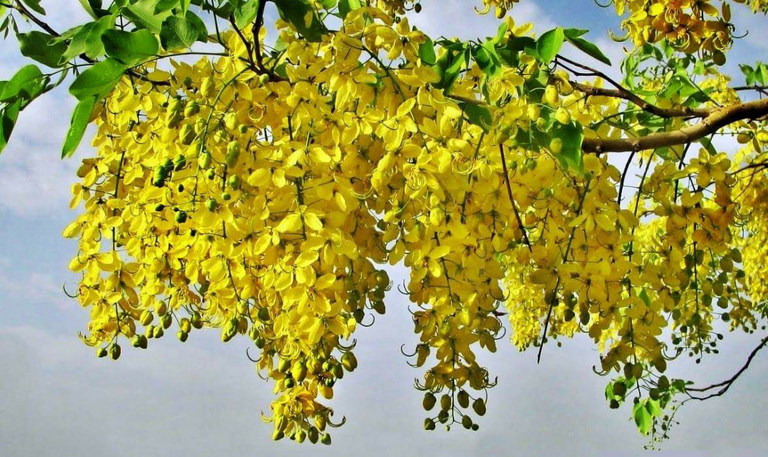
aquilegia looking very beautiful.I never seen any flowers like this.Really these flowers is so beautiful. Now i am just thinking about its smell.These flowers are so beautiful so how nice will be its smell?
No smell, just nice flowers !
'You've never seen a columbine done by a black child never they ask say, we can't believe it happened here we can't believe it's these Suburban white kid's.'
It's only them!
Hard to understand your comment but thanks anyway.
Very beautiful flowers with different colors. It's a very pleasant color to enjoy. There is a deep sense of peace and touches the very recesses of the soul. Thank you for sharing very beautifully @ctrl-alt-nwo!
lovely photography
beautiful flowers with variant colors ,,, but I have never found this flower in my place of residence
Wow that's great flower garden post...
magoo-2 found a series of multi accounts of a same owner is following your articles to cheat your generous rewards.
magoo-2 found these accounts are suspicious & can be multi accounts of a single owner. Conclusion is based on last 30 days transactions:
@triptybarsha
@rakib786
@sujonkhan
@sujonmia
@imamulkhan
@roky77
@dilshan77
@feju
@imu420
@bulet07
magoo-2
Check our latest multi comment spam update report
Well, this is a very beautiful flower and I really like flowers, it seems in Indonesia this flower does not exist, maybe.
They are gorgeous.
These flowers have lovely petals, very strangely designed by nature. I hope they have nice perfume too!?
No perfume !
Beautiful
This is very beautiful garden infomation. .it is very looking for this Aquilegias for garden.
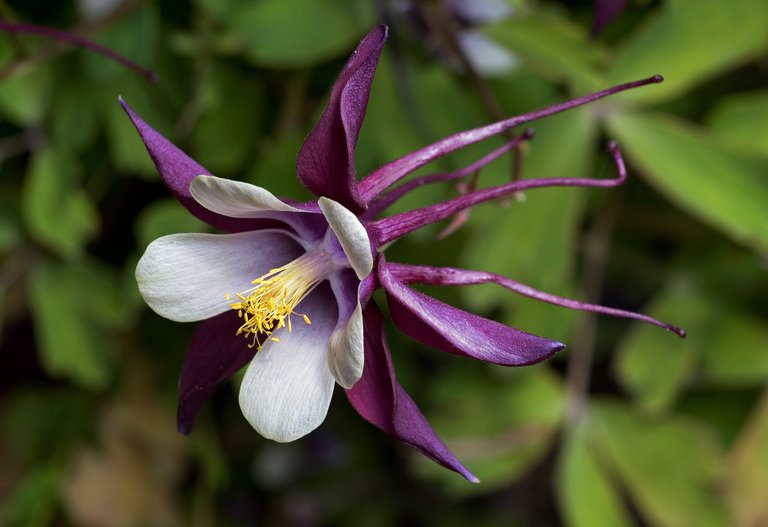

Thanks @ctrl-alt-nwo
Have a great day
Quote the SOURCE for photos next time, otherwise you copy others work.
Unbelievably so beautiful this is so glorious to check out :)
Aquilegias are so awesome thanks a lot @ctrl-alt-nwo
Amazing pics taken, yellow, red,white, pink all are awesome flowers . Good